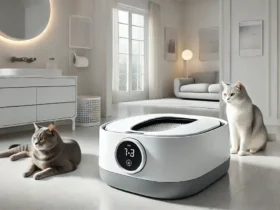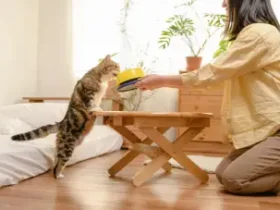Introduction
Training cats to use litter boxes is a difficult task. Usually, kittens learn from their mother to use a cat litter box. But if anyone brings a feral cat or starchy fur kiddo or adopts a kitten or rescues one from the street, then she/he has to take responsibility for training this cat to use a litter box. You must know about how to train a cat to use a litter box. However, this training process may take time, but you will get a long-term result, and at the same time, you don’t need to worry about pee and poo all around the house. Before training your cat, you must know about their instincts, behavior, and traits. So considering all these things, you have to proceed.
Easiest way to litter train a kitten or cat
If you bring a new kitten into your house, you must train that kitten to use a litter box. For the first couple of days, you should keep your cat in one room where you keep food and water aside, and on the other side, keep the litter box. Keep the room without carpet, like a bathroom. Then place them in the litterbox after a meal or nap. Once your cat gets used to the litter box, then you can permit them to explore other rooms of the house. Don’t move the litter box until your cat is fully used to the box. Sometimes when your cat can pee or poo outside of the box, don’t punish them because it can confuse, fear, and anxiety in the cat. If accidentally they do it immediately, quickly and calmly pick them up, and place them in the litterbox. If they suddenly stop using the litter box, then immediately see a veterinarian doctor and try to find out the cause. It can be a medical issue. Sometimes trained cats also forget to use litter boxes and pass their potty outside of the box. If this happens, don’t be upset, stay calm and try to retrain your cat. This problem is quite natural. In the meantime, love your cat and enjoy meaningful time with them.
How do you choose the perfect cat litter box for your pet
Kitten litter box training starts with choosing the perfect litter box. Sometimes cats can be picky, so choosing the right litter box is mandatory for your cat. You have to be careful while choosing a litter box so that your cat can move around comfortably. Expensive branded litter boxes can work, but you should keep in mind the preferences of your cat. Place two litter boxes side by side in your house so that cats can easily find them. Keep litter boxes away from cats’ food and water. Keep the litter box clean and encourage them to use it.
1. Choose the right size
The right litter box size is very important for cats. If the litter box is too small or big, it can be the cause of not using the cat. The kitten litter box size should be 13 inches by 9 inches. And if your cat is growing, then you should choose a large-sized litter box. If your cat is small in size or older, choose a low-sided box so that it can easily be used without facing any problems.
2. Covered or uncovered
Some cats prefer covered litter, and some cats prefer uncovered. Both litter have advantages and disadvantages. You can try both litter boxes to know which type of litter your cat can choose. The big advantage of covered boxes is that they can maintain cats’ privacy. But sometimes cats feel uncomfortable or uneasy while using a covered box. Because they can’t see outside. On the other hand, covered litter boxes sometimes create odor inside of the box, which is more and more unappealing to the cat. However, experts say to use an uncovered box for cats.
3. Use more than one box
If you have 3 or 4 rooms in your house, place a litter box in each room so that cats can easily find them and use them. If you have more than one cat and they are still learning to use the box, then you must need one litter box per cat. At the same time, you also place an extra litter box in your house.
4. Place the litter box in the right location
Sometimes we think, Why do cats poop outside the litter box? Proper placement of the litter box is very important for cats. If the litter box becomes available to cats, they can easily use it. Placing multiple boxes in different places in the house also encourages a cat to use the box. You must keep in mind that don’t place the box near cat food or water. Also, don’t place it in a noisy place. Cats like to relieve themselves in calm and quiet places.
Selecting the best cat litter box
There are various types of litter boxes. You have to choose boxes according to your cat’s preference. Here are some tips that help you choose the box:
1. Clumping Litter
This type of box is made of clay and clumps, and when it comes in contact with moisture, it becomes very easy to scoop out the urine. It controls odor as well, and just because only soiled areas need to be removed, that’s why it lasts longer. It also keeps the box clean, that’s why this type of box is popular, but this box may be a little dusty, so it is not good for sensitive cats and people with respiratory syndrome as well.
2. Non-Clumping Litter Box
This type of box is made of clay, pine, or other different materials. It needs to change frequently, but it helps to reduce odor if you change regularly. These boxes absorb moisture but can’t form clumps; that’s why urine spreads all over the box. But this type of box is more affordable than clumping boxes.
3. Crystal Litter box
This type of litter is made of silica crystals. Crystal litter has excellent power to absorb moisture. It finely absorbs urine, which helps to control the bad smell. It is lightweight, and it has long-lasting capability but is a little bit expensive. Some cats don’t like this type of box, but if you introduce your cat frequently with crystal litter, they may get used to it.
4. Biodegradable Litter box
This type of box is eco-friendly and made of natural, renewable materials like wood, corn, wheat, or paper. It also controls odor. Absorption systems can vary from material to material. This type of box doesn’t create any bad impact on the environment.
5. Scented Litterbox
A scented litter box can reduce odor and add fragrances like lavender, lemon, or fresh scent. Scented boxes can be clumping, non-clumping, or crystal-based. It depends on the product or brand. But some cats don’t like scented boxes. So you can taste your cat before buying.
How to Clean Your Cat’s Litter Box
Regular cleaning of your cat litter box is essential for keeping your house clean and odor-free, and your cat will be happy as well.
Scoop out the waste materials or urine daily and keep this waste in a plastic bag.
Tie the plastic bag so that bad smell can’t spread and throw it in the trash.
Refill the litter box with fresh materials and maintain the depth so that your cat can get enough room to dig.
Try to empty the whole box once or twice a week and refill it with new materials.
Wash the box with mild and unscented soap. Avoid strong-scented cleaners like bleach and ammonia. Because these can keep cats away from the box.
After cleaning, dry the box and fill the box with new materials.
Use vinegar one time a month to clean the box, and the portion of vinegar and water should be 1:1. This vinegar solution can help to reduce bad odor from the box.
Using box liners helps to clean the box easier, but some cats don’t like it, so observe your cat before using it.
Wash your hands with germ-killer soap and warm water after cleaning the box to prevent bacteria or germs.
Conclusion
So in the end, it may be said that for cat litter training, you have to learn the schedule that will help you to train them. Generally, cats like to relieve themselves after a meal or wake up. So at this time, you can place them in the litter box instead of other places. Some cats like to relieve themselves after playing and running around. So you have to play with them near the litter box.
When you realize that this is the time to pass the potty of your cat, you immediately place them in the box. If your cat doesn’t know how to dig or bury the waste, teach them with your hand and finger. So if you follow the process and buy the right litterbox, your cat will also learn the use of a litterbox. You have to be patient, and you will get a good result.





Leave a Reply